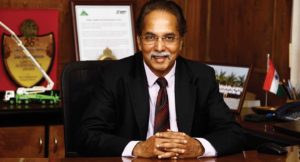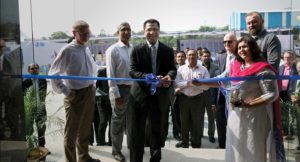Ramesh Kymal, Chairman and Managing Director, Gamesa India, and Chairman CII Tamil Nadu, states that the company has invested in India significantly to satiate the country’s growing need for alternate sources of energy to meet the growing demand for power.
Gamesa India, a part of the €3.5 billion Spanish multinational Gamesa Corporation, has expanded rapidly in the last seven years of its presence in India. “We installed our first turbine in the year 2010 after which Gamesa became the market leader in Tamil Nadu in 2011,” states a proud Ramesh Kymal, Chairman and Managing Director of the company and also the Chairman of CII Tamil Nadu. So far, the company, which has an operating fleet of wind farms spread across 7 states in the country, has a total installation base of 2600 MW which has helped it sustain its leadership position over the last two years. In 2015, the company also introduced its latest wind turbine which is tailor-made for low wind speed sites in India.
Drawing on its expertise from wind energy, Gamesa India entered the solar business in 2015, offering solar energy solutions to utility scale solar projects, distributed generation based solar EPC, micro grids – rural electrification and solar asset management. The company entered the market with a 10 MW order last year and bagged a slew of orders in Tamil Nadu, Telangana and Srilanka. Currently, Gamesa India has commissioned about 16MW of solar power projects in India and around 64MW of projects is under execution. “Given that only 3.8 GW out of the potential 750 GW has been harnessed so far, we see a huge market opportunity for solar in the country,” says Kymal.
Considering the rising energy crisis in the country, the government is also focussing on setting long term policies to boost this sector. For instance, it has set a target of generating 100 GW of power from solar resources by 2022. It is also estimated that about 10 GW of utility-scale solar and grid connected roof top solar capacity will be added by 2016-17. “All these measures have encouraged us to take the lead when solar is witnessing a positive curve in the country,” adds he.
The game changer
“The renewable energy sector is a key contributor to this Make in India campaign,” believes Kymal. The sector evolved through the wind industry and has always been a great supporter of the campaign for many years. The Government policies and strong certification system has encouraged the industry to build a robust manufacturing hub in India. “Today, the total production capacity of the Indian wind industry adds up to 9600 MW per annum which will certainly help us in achieving the wind targets of 60 GW by 2022,” states Kymal.
As far as employment opportunity is concerned, the International renewable energy agency’s report holds that Indian renewable energy industry has already generated 400,000 jobs and is expected to generate a million jobs by 2022, if the said targets are achieved.
The Union Budget has also made certain provisions that will have a long term impact on the renewable energy industry’s growth. “Increase in clean energy cess from Rs.200 to Rs. 400 is a welcome move and we hope that the Government will actively deploy these funds to facilitate growth of renewables across India,” states Kymal. However, the Government has set sunset clause on tax holidays under Sec80IA (Mar 2017) and also reduced the accelerated depreciation from 80 per cent to 40 per cent from the same date. “Any alteration or removal of the existing fiscal incentives will certainly pose challenges to the industry in achieving the ambitious government targets of 60 GW of wind power by the year 2022,” adds he.
On the infrastructure front, Kymal is of the opinion that immediate attention needs to be given to building adequate grid infrastructure so that maximum energy can be harnessed out of the available resources. The sector will also benefit from availability of long term affordable finance which will help private investments into infrastructure. This apart, flow of funds from the National Clean Energy Fund to the renewable energy sector will further help in the development of RE Infrastructures, such as a green energy corridor, that are very specific to the sector.
Fulfilling the demand gap
Gamesa has invested in India significantly to satiate the country’s growing need for alternate sources of energy to meet the demand for power. “We have established strong foundation in wind and with our presence in solar, we are confident that our initiatives will contribute to the Make in India campaign significantly and also provide more employment opportunities consistent with our growth curve,” says Kymal.
Today, wind sector is a comparatively mature industry and has witnessed incremental technological advancements over the years. “We believe technology is a key differentiator and in order to be on top of this innovation wave, we are tapping technology for low wind sites which are abundant in India,” states Kymal.
The company is also innovating in its operations and maintenance space. With the advent of sophisticated turbine level sensors, conditioning monitoring systems and SCADA systems, Gamesa remotely analyses a large amount of real time data from the turbines and uses such data into actionable points, based on the years of operational experience.
Since commencing operations in India, the company has invested over € 180 million towards expanding manufacturing capabilities, skill development and capacity addition. The company set up its facility in Red Hills, near Chennai to make the G58-850 kW wind turbine. It further invested in 3 units across India – a state-of-the-art nacelles assembly factory in Mamandur, Chennai, a modern integrated blade manufacturing facility and a tower fabrication joint venture unit in Halol, near Vadodara, Gujarat. These investments coupled with local supply chain integration have enabled the company to indigenize 80 per cent of its 2.0MW product lines.
Gamesa India currently employs more than 1800 people across manufacturing, wind farm operations and services across India. Manpower requirement in the industry can be classified as pre-construction, manufacturing, construction and post-construction. During the pre-construction phase, highly qualified specialists are required in research, design and project development areas. In the manufacturing, construction and post-construction phase, more skilled manpower is required for turbine production, civil and electrical works, erection and commissioning and maintenance of wind farms. Wind as an industry requires more manpower during construction and post-construction phase. Out of the total workforce in Gamesa India, the above two phases account for over 70 per cent of the manpower. The remaining manpower is employed in business development and design.
Where to from here?
For the renewable energy sector as a whole, the future looks optimistic as stakeholders are realising the benefits of shifting to clean energy sources, thus reducing carbon footprint. “We feel the future of the sector lies in how well it can derive benefits from solar and wind energy optimally,” states Kymal. Futuristic models such as hybrid-solar in the day and wind at night will seek exploration.
With the business landscape looking optimistic, manufacturers are having concrete investment plans for the next few years. “The future is brighter today with the economy expected to grow and government providing the growth impetus to the manufacturing sector through a wide range of policy changes. In my view if the confidence-building measures for investors gain momentum and regulatory processes are streamlined, manufacturing sector will achieve the next level of growth,” concludes Kymal.





